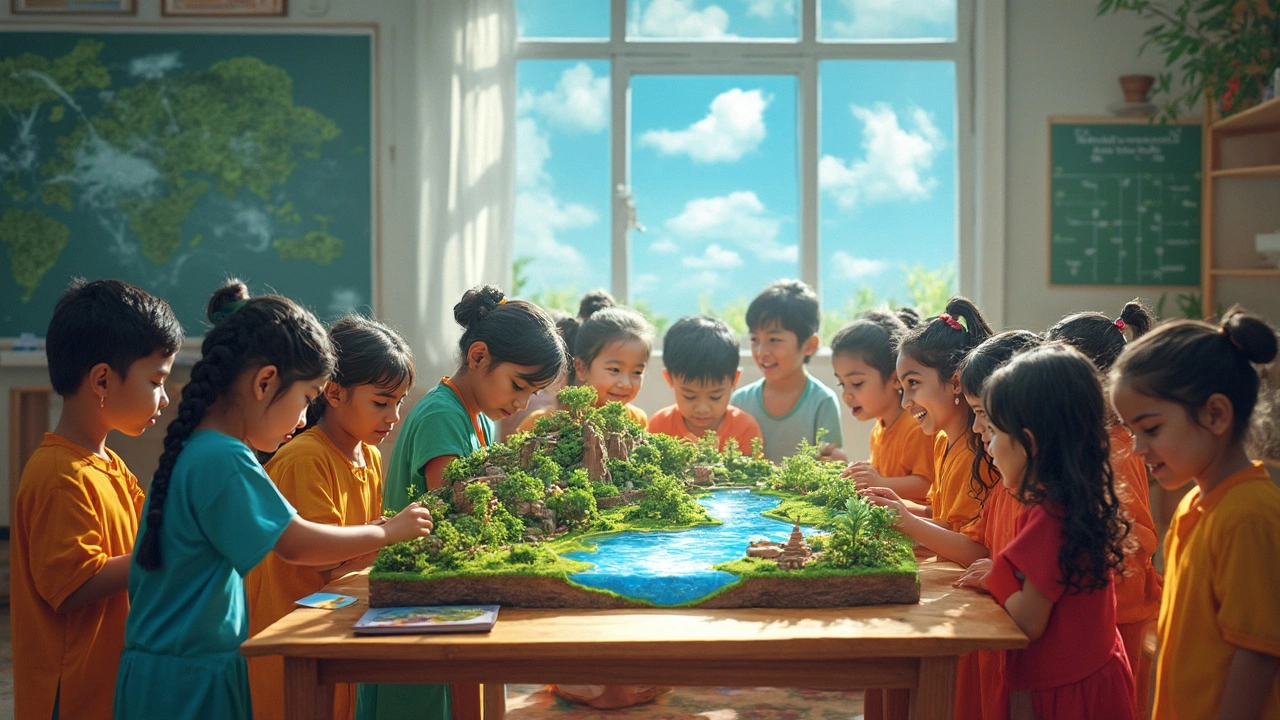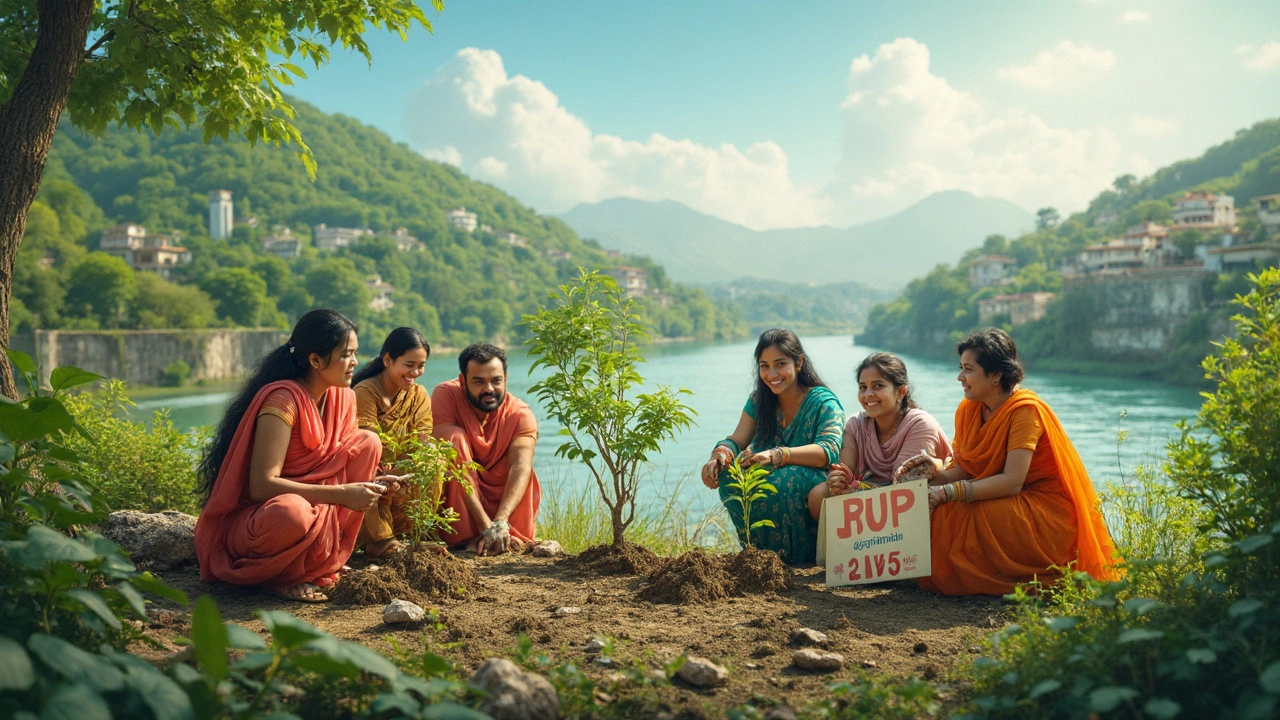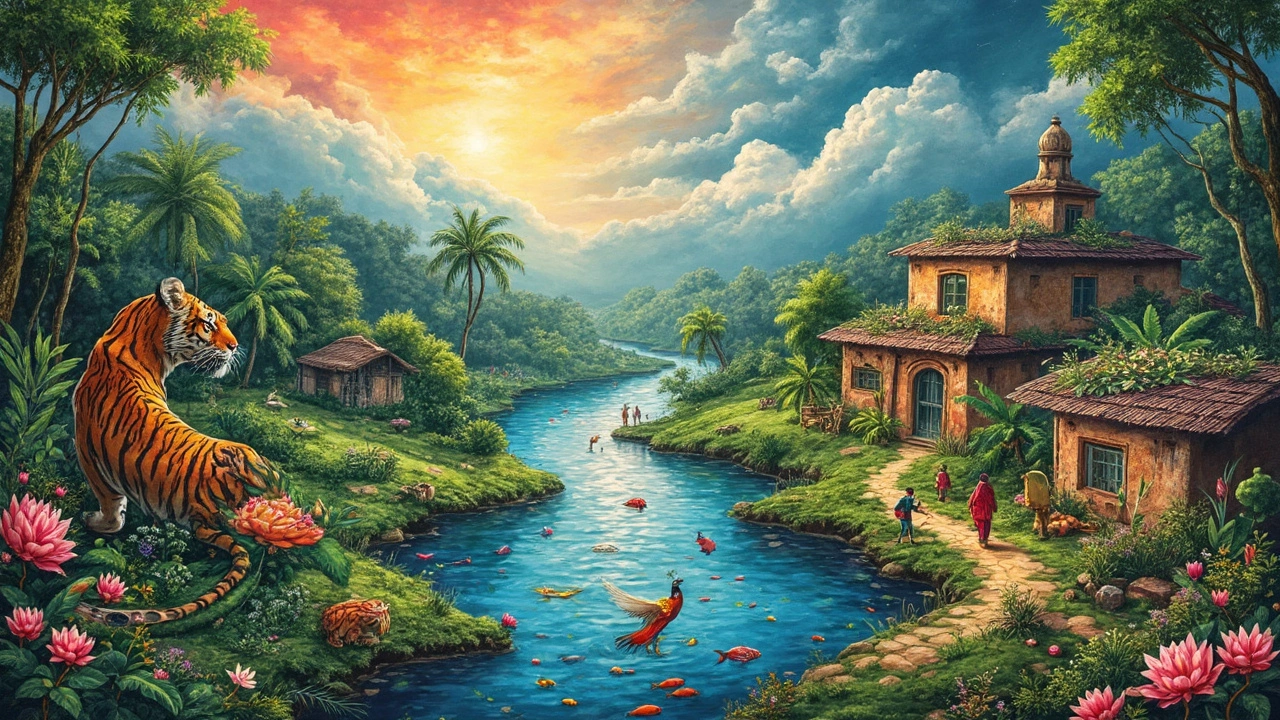Most of us take our surroundings for granted, but have you ever stopped to think about how the space around you fits into a bigger picture? The world is divided into four major environments, and knowing about them isn’t just for nature buffs. These environments shape our health, the food we eat, the air we breathe, and even the pets we keep at home.
If you can remember these four—land, water, air, and man-made—you're already ahead. Each one comes with its own rules. The plants that survive in the dusty Sahara can’t handle being underwater. Fish don’t thrive in your neighborhood park. Sounds obvious, but the lines between these environments—like marshy wetlands or bustling city parks—can be places of real environmental action.
Whether you're planning a hike, picking out houseplants, or just looking to waste less water, understanding the basics of these four environments can make a real difference. You'll spot why some wildlife groups save rivers while others care for city trees. After all, each environment needs its own kind of protection and its own style of care.
- Breaking Down the Four Environments
- Terrestrial Life: Land-Based Wonders
- Aquatic Spaces: Fresh and Saltwater Worlds
- Atmospheric Dynamics: The World's Breathing Room
- Human-Made Environments: Our Designed Spaces
Breaking Down the Four Environments
Let’s get honest: the way we divide up the Earth helps us understand how life spreads across the planet. Scientists—and just about every environmental group out there—agree there are four big players, or as you’ll hear them called, the four major environments. Each one seriously shapes how we live and what lives with us.
- Terrestrial (Land): This is everything solid underfoot, from forests and grasslands to deserts and mountain ranges.
- Aquatic (Water): This covers all the lakes, rivers, seas, and oceans—and even the puddle in your backyard. It’s the biggest life supporter on the planet, with oceans alone holding about 97% of all the water on Earth.
- Atmospheric (Air): This includes everything from the oxygen we breathe to the weather systems moving around us. It’s our global climate engine, keeping life in balance.
- Human-made (Anthropogenic): This isn’t just cities and towns. It’s also farmlands, roads, dams, and pretty much anywhere humans have changed the land or water from its natural state.
To really see how these add up, check out this quick comparison:
| Environment | Main Features | Fun Fact |
|---|---|---|
| Terrestrial | Land, soil, plants, animals | The Amazon covers 5.5 million sq km—about the size of Australia. |
| Aquatic | Freshwater & saltwater bodies, aquatic life | Coral reefs support about 25% of all marine species. |
| Atmospheric | Gases, weather, climate | Earth’s atmosphere is about 480 km thick, but 75% of its mass is in the lowest 11 km. |
| Human-made | Cities, farms, infrastructure | Urban areas now house 56% of the world’s people as of 2024. |
It’s not just about knowing where things live. The border between these environments is where most change—and most problems—happen. Flooding in cities, droughts on farmland, smog in the air; these all show what happens when the boundaries blur. If you want to help protect the world, start by knowing who’s playing and what side they’re on.
Terrestrial Life: Land-Based Wonders
When you hear "terrestrial environment," think of everything that's not underwater or floating way up in the sky. We're talking about forests, deserts, grasslands, tundra, and even your own backyard. This is where you’ll find around 80% of all known species—including mammals, birds, insects, and most plants.
Forests are home to more than half of all terrestrial species, with tropical rainforests alone holding crazy levels of biodiversity. The Amazon is a beast, covering 5.5 million square kilometers and producing 20% of the world’s oxygen. Rainforests also suck up about 2 billion tons of carbon a year—if that doesn’t show their value, not much will. Even deserts, which seem empty at first glance, have hidden gems like cacti storing gallons of water and animals like the fennec fox built for survival.
Let’s look at the numbers:
| Environment Type | Key Example | Percent of Earth's Land Coverage |
|---|---|---|
| Forests | Amazon Rainforest | 31% |
| Grasslands | Great Plains | 30% |
| Deserts | Sahara | 33% |
| Tundra | Arctic tundra | ~10% |
What’s wild is how these land areas handle threats differently. Grasslands catch wildfires, then bounce back thanks to deep-rooted plants. Tundra zones store carbon in frozen ground—trouble is, melting permafrost can release all that carbon right back in a hurry.
- If you want to help, try planting native trees or wildflowers, not just typical lawn grass. Native plants support more bugs and birds.
- Reduce your paper and wood use to cut down on deforestation.
- Get to know local wildlife and support parks or preserves in your area. Your backyard might be a tiny wildlife haven.
So next time you walk outside, take a second to realize just how much weird and wonderful stuff is going on. The major environments on land are packed with life—and need all the protection they can get.

Aquatic Spaces: Fresh and Saltwater Worlds
Water covers about 71% of Earth's surface, which means aquatic environments are everywhere, whether you’re near the ocean, a lake, or just the neighborhood creek. Aquatic spaces come in two main flavors: freshwater and saltwater. Each has its quirks, its own set of plants and animals, and different challenges when it comes to keeping them healthy.
Freshwater environments include rivers, lakes, ponds, and wetlands. These make up just about 2.5% of all water on Earth, and most of that is locked up as ice or deep underground. So, places with clean, accessible freshwater are actually pretty rare, which is a big deal because every person, animal, and plant living away from the coasts depends on it for survival. Aquatic insects, frogs, and fish like bass or trout are freshwater regulars. Wetlands, sometimes called nature’s kidneys, are especially cool because they filter out pollution naturally and help control flooding.
Saltwater environments mean our oceans and seas. These are the ultimate big leagues—covering way more space than forests or deserts combined. From coral reefs to deep ocean trenches, saltwater homes are where you find a wild range of creatures: jellyfish, whales, and tiny plankton that actually help create the oxygen we breathe. Coral reefs alone support an estimated 25% of all marine species, even though they take up less than 1% of the ocean floor.
Now, here’s something most folks ignore: these two types of aquatic spaces meet at estuaries. Estuaries are mixes of salt and fresh water and act like super nurseries for many fish and shellfish. Protecting them is a huge focus for many major environments groups, since pollution and overfishing can cause massive long-term issues for both oceans and rivers.
| Aquatic Environment | World Coverage | Main Threat | Key Species |
|---|---|---|---|
| Freshwater | 2.5% of Earth's water | Pollution, overuse | Frogs, trout, cattails |
| Saltwater (Ocean/Sea) | ~70% of Earth's surface | Overfishing, warming, acidification | Coral, tuna, whales |
| Estuaries | Tiny (in area), vital for life cycle | Pollution, development | Salmon, crabs, oysters |
If you want to help, small changes count. Don’t dump oil or chemicals down the drain—it all circles back to water. Cut back on single-use plastics, since tons of that stuff ends up floating out at sea. Taking part in local waterway cleanups, even once a year, makes a difference. Clean water means healthy people, fish, and even more fun at the lake or beach without worrying about pollution alerts.
Atmospheric Dynamics: The World's Breathing Room
When people talk about the "air we breathe," they're talking about the atmosphere—Earth’s giant, invisible shield. This layer of gases does more than just fill your lungs; it keeps the planet warm enough for life, blocks harmful rays, and mixes up the weather that annoys or delights us every day.
The atmosphere has five main layers. Most of what we care about happens in the lowest one, called the troposphere. This is where clouds form, planes fly, and weather happens. The next layer, the stratosphere, is famous for holding the ozone layer, which soaks up most of the sun’s dangerous UV rays. If that ozone gets thin, everyone’s more at risk for skin cancer, which is exactly why people freak out about holes in the ozone layer.
Air pollution is way more than just a city problem—it messes with the whole atmosphere, trapping heat and making storms nastier. The main troublemakers are carbon dioxide, methane, and other greenhouse gases. These build up from car exhaust, factories, electricity use, and even too many cows. It’s no secret the atmosphere is warming up, causing heat waves and unpredictable storms a lot more often than just a generation ago.
Don't think you have zero control here. Even small changes at home or work cut down on pollution. Try these:
- Swap out car rides for biking, walking, or public transport once or twice a week.
- Upgrade old appliances or lightbulbs to energy-saving ones.
- Cut down on single-use plastics—they release greenhouse gases at every step, from production to landfill.
- Support clean energy when you can, like solar or wind.
Plenty of environmental groups focus on atmospheric issues—pushing for clean air laws, lobbying against polluters, or running tree-planting drives (because trees are nature’s air filters!). Every bit helps keep our "breathing room" balanced so the rest of the major environments can function properly.

Human-Made Environments: Our Designed Spaces
Human-made environments are everywhere. Cities, suburbs, farms, roads, factories—the list goes on. Even the park down the street or your school playground didn’t just appear; people planned, built, and reshaped every part. These spaces play a huge role in our lives and actually shape how ecosystems work for plants, animals, and people.
Here’s the thing: most people interact with human-made environments way more than natural ones. Urban areas now house over 55% of the world’s population, and experts predict as many as 68% will live in cities by 2050. That means these environments matter for health, happiness, and even how we connect with nature.
But just because something’s paved or planted by humans doesn’t mean it’s all bad for the planet. In fact, greener urban areas have proven benefits—they lower stress, help fight air pollution, and keep cities cooler in summer. Simple things like planting trees along streets or putting rooftop gardens on buildings make a measurable difference.
Here are some ways you can make better choices for these spaces:
- Support community gardens or join tree-planting events. These boost local biodiversity and offer food or green spaces for everybody.
- Use public transport, bike, or walk when possible. Less car traffic means cleaner air and quieter neighborhoods.
- Reduce waste: recycle, compost, and pick up litter where you see it. Every small action adds up to a cleaner environment.
Environmental groups working in major environments often focus on city areas because this is where small actions can snowball into big improvements. Groups push for better recycling, encourage more parks, and protect urban streams from pollution. If you ever thought cities are totally disconnected from nature, think again—these designed spaces are part of the bigger environmental puzzle.
